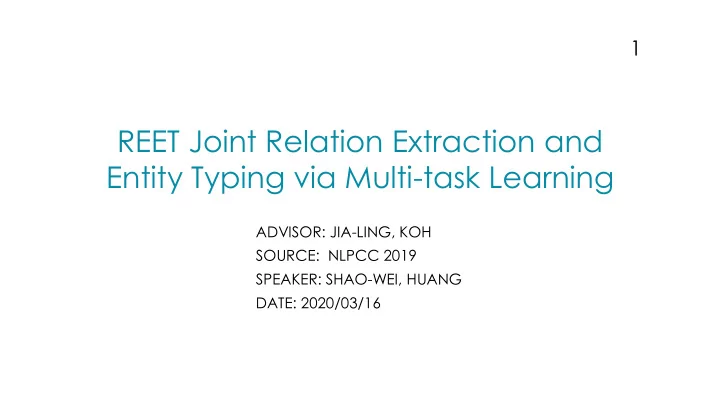

1 REET Joint Relation Extraction and Entity Typing via Multi-task Learning ADVISOR: JIA-LING, KOH SOURCE: NLPCC 2019 SPEAKER: SHAO-WEI, HUANG DATE: 2020/03/16
2 OUTLINE ⚫ Introduction ⚫ Method ⚫ Experiment ⚫ Conclusion
3 INTRODUCTION ➢ Relation Extraction ( RE ): Extracting semantic relations between two entities from the text corpus. (Ex): Steve jobs was the co-founder of apple. Co-Founder
4 INTRODUCTION ➢ Entity Typing ( ET ): Assign types into the entity mention in a sentence. (Ex): Steve jobs was the co-founder of apple. Person Company
5 INTRODUCTION ➢ Most existing works solve RE and ET separately and regard them as independent tasks. ➢ In fact, the two tasks have a strong inner relationship. REET Model Joint Relation Extraction and Entity Typing.
6 INTRODUCTION Problem definition ➢ Given a sentence s = { 𝑥 1 , 𝑥 2 , … 𝑓 1 , … , 𝑓 2 …} and two target entities ( 𝑓 1 , 𝑓 2 ). ➢ Subtasks : 1. Relation extraction for the entity pair. 2. Entity typing for 𝑓 1 . 3. Entity typing for 𝑓 2 .
7 OUTLINE Introduction Method Experiment Conclusion
FRAMEWORK 8 8 Entity Typing Relation Extraction
9 METHOD Relation Extraction Module ➢ For a sentence s = { 𝑥 1 , 𝑥 2 , … 𝑓 1 , … , 𝑓 2 … 𝑥 𝑜 } , transform each word 𝑥 𝑗 into : 1. Word embeddings 2. Position embeddings : Encodes the relative distances between 𝑥 𝑗 and the two entities. 2 -3 𝑥 𝑗 (Ex): Steve jobs was the co-founder of apple.
METHOD Relation Extraction Module 10 ➢ Convolution and Piecewise max pooling : Word + Position Filters Embeddings Steve Jobs Piecewise f 1 f 2 f 3 f 4 was max pooling the 0.7 0.7 0.7 0.8 co-founder 0.8 0.9 0.9 0.9 of 0.6 0.2 0.2 apple Tanh 0.5 0.5 0.6 0.6 Sentence Input Convolution representation S
11 11 METHOD Entity Typing Module ➢ Input Layer : Shared with RE module. 1. Word embeddings. 2. Position embeddings. ➢ Bi-LSTM layer : Obtain the hidden state(high-level semantic representation) of each 𝑥 𝑗 .
METHOD Entity Typing Module 12 12 ➢ Couple Attention : To get entity-related representations for sentences. ⚫ Treat entities as query, other words as key. ⚫ Final representation ⚫ of two ET tasks : The weights of the i-th word entity1, entity2 under the m-th entity Weight sum : ⚫
13 METHOD Multi-task Learning Framework ➢ REET1 : Treat RE task and ET task are independent and only share input embedding layers. ⚫ ⚫ S 𝐔 𝟐 𝐔 𝟑 Prediction probabilities for RE and ET respectively.
14 METHOD Multi-task Learning Framework ➢ REET2 : Concatenate representations of RE and ET before the last classication layer. ⚫ ⚫ S 𝐔 𝟐 𝐔 𝟑 Prediction probabilities for RE and ET respectively. ***RE and ET can share a high-level feature with each other.
15 METHOD Multi-task Learning Framework ➢ Loss Function : Cross entropy loss. ⚫ ➢ Multi-task Learning : Add the loss of each task together. ⚫ Balance weight
16 OUTLINE Introduction Method Experiment Conclusion
EXPERIMENT https://ai.googleblog.com/2013/04/50000-lessons- on-how-to-read-relation.html 17 Dataset ➢ NYT+Freebase : Aligning entities and relations in Freebase with the corpus of New York Times. ➢ Google Distant Supervision(SGD) : Extracted from Google Relation Extraction corpus and is a human-judged dataset.
https://blog.csdn.net/u013249853/article/details/961 EXPERIMENT 32766 18 Performance in RE
19 EXPERIMENT Performance in ET
https://blog.xuite.net/metafun/life/65137005- Information+Retrieval%E7%9A%84%E8%A1%A1%E9%8 20 7%8F%E6%8C%87%E6%A8%99-MAP%E5%92%8CMRR EXPERIMENT *** Parameter analysis
21 OUTLINE Introduction Method Experiment Conclusion
22 CONCLUSION ➢ Propose a multi-task learning frame that integrates relation extraction task and entity typing task jointly. ➢ The two tasks share low-level (i.e., input embedding layer) and high-level information (i.e., task-specic feature). ➢ Both relation extraction task and entity typing task achieve a signicant improvement and our approach outperforms many baseline methods.
Recommend
More recommend